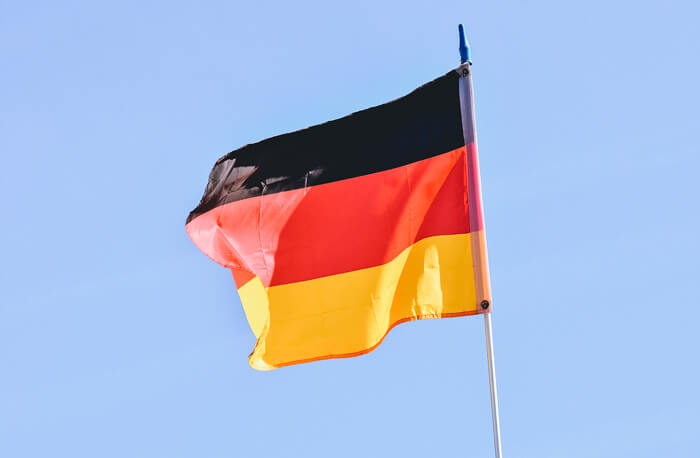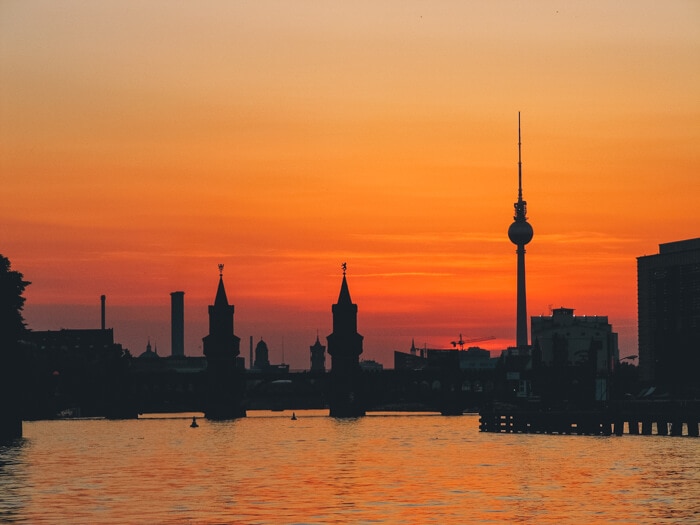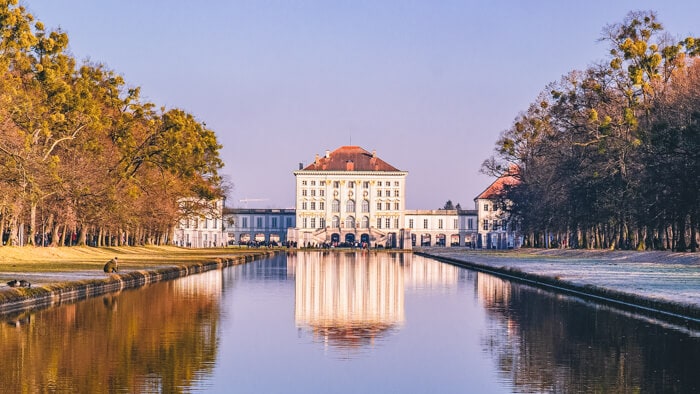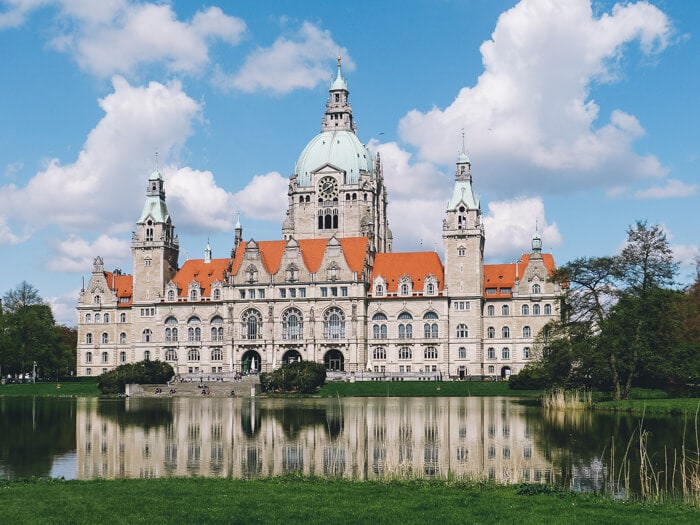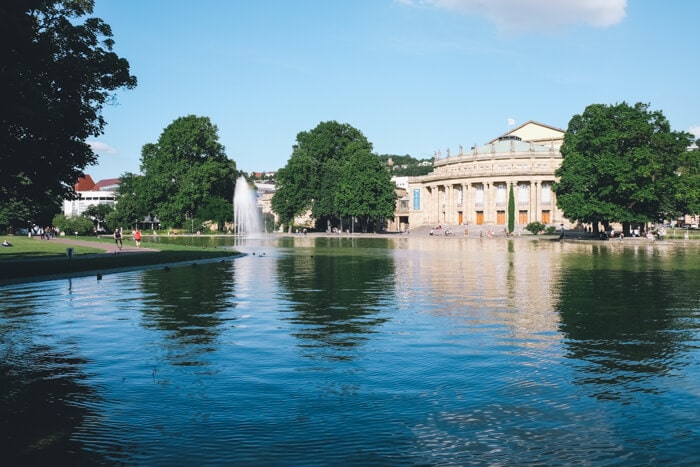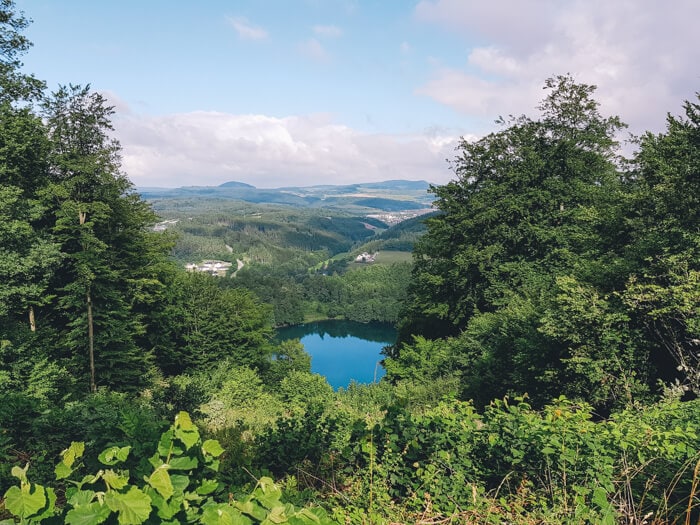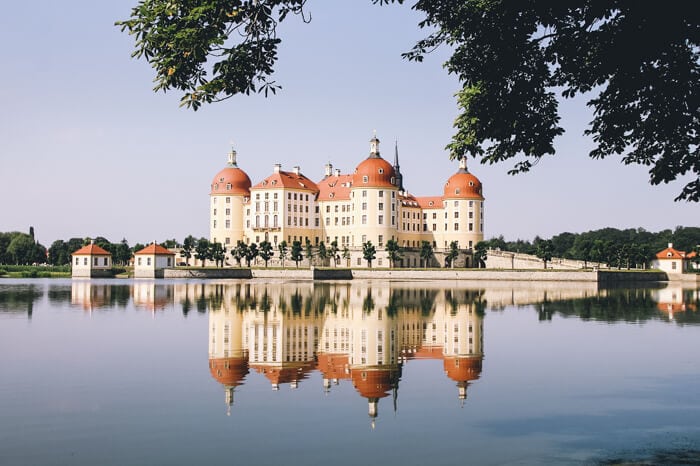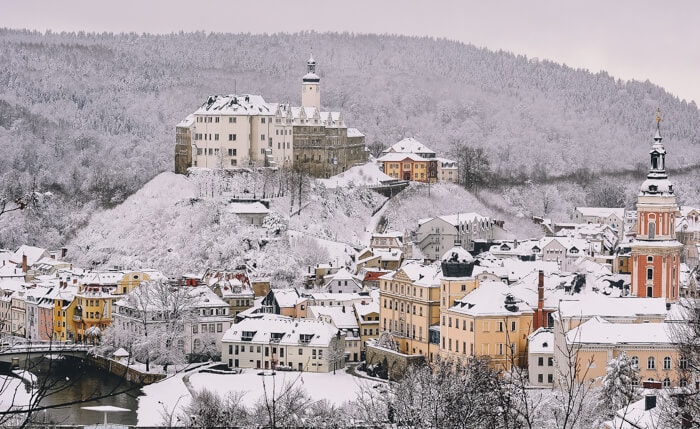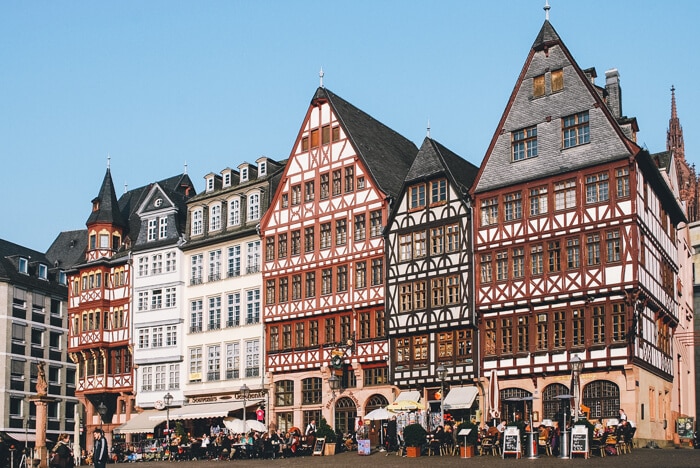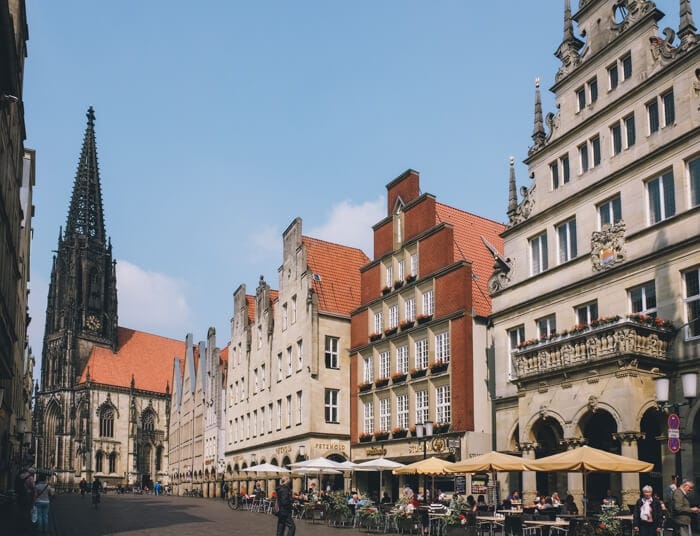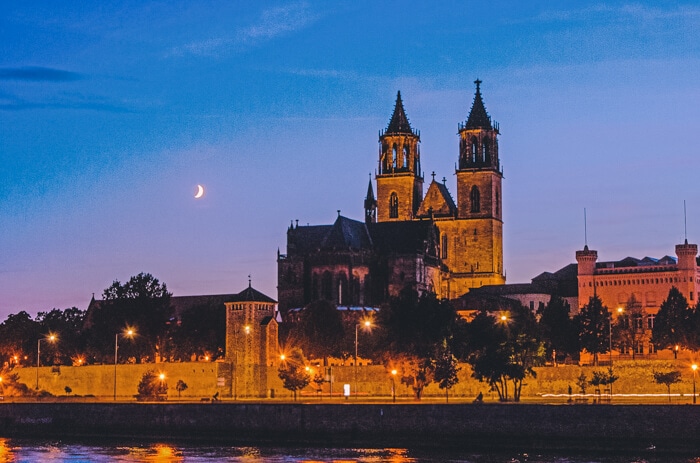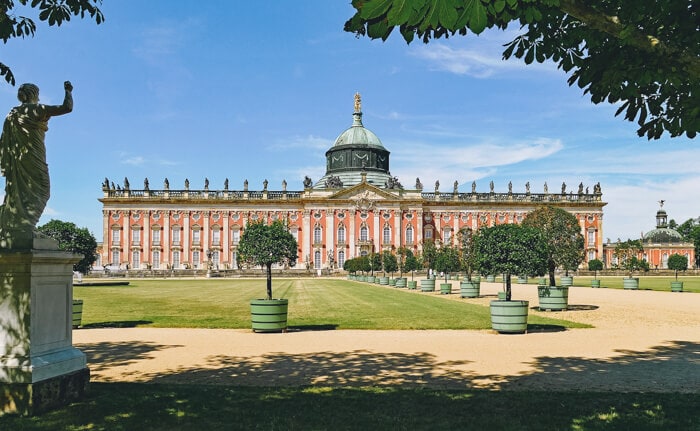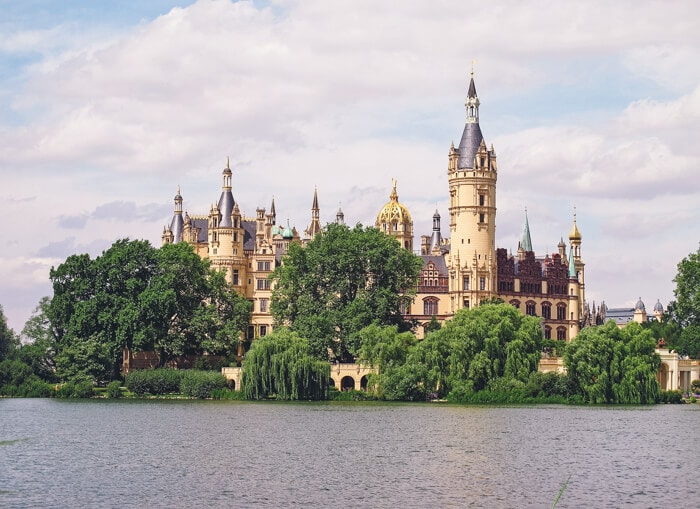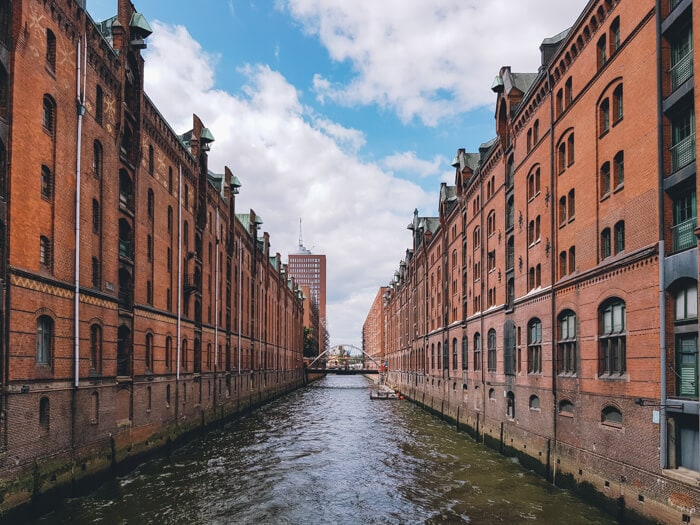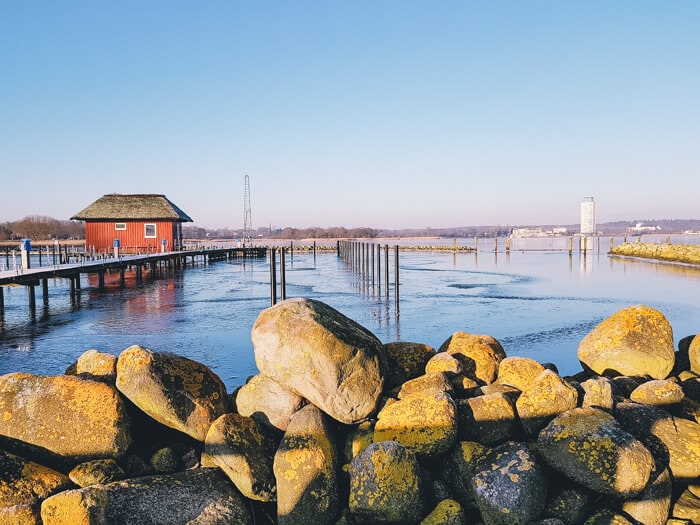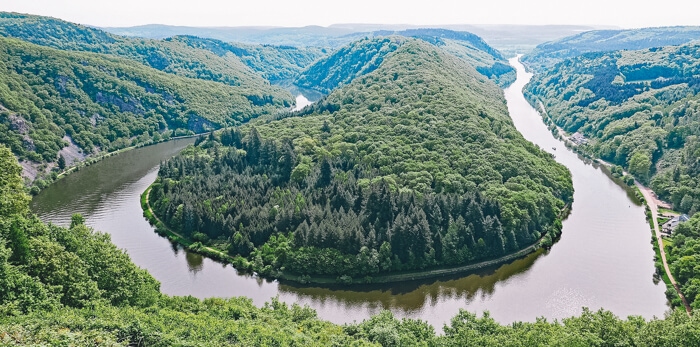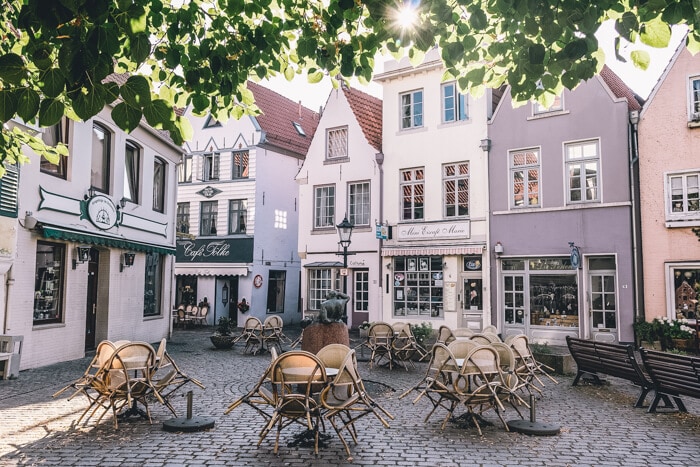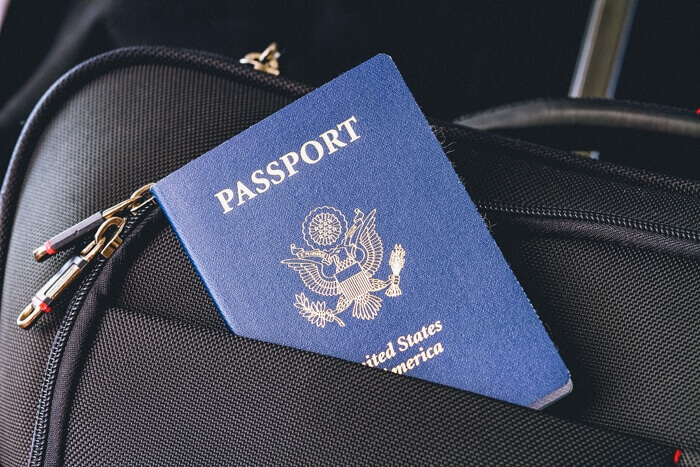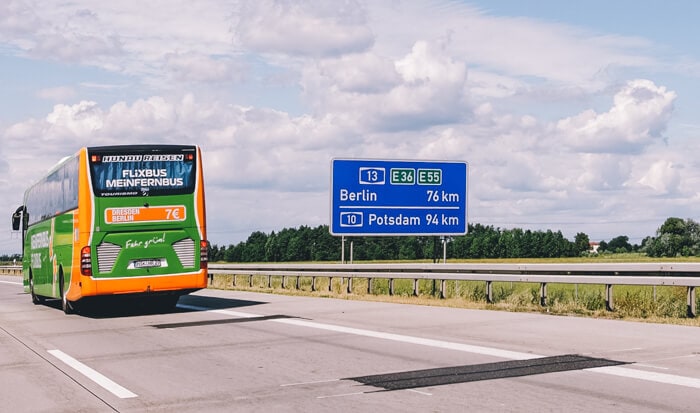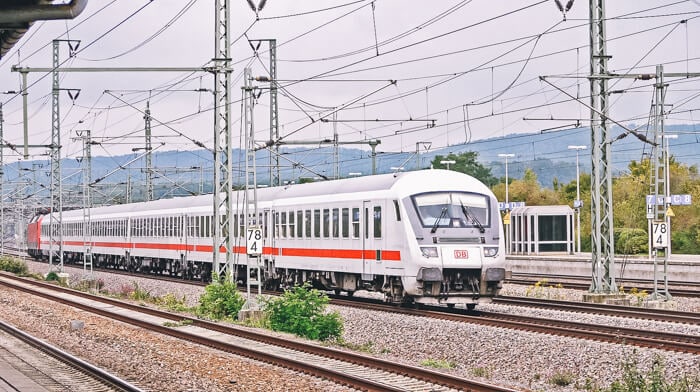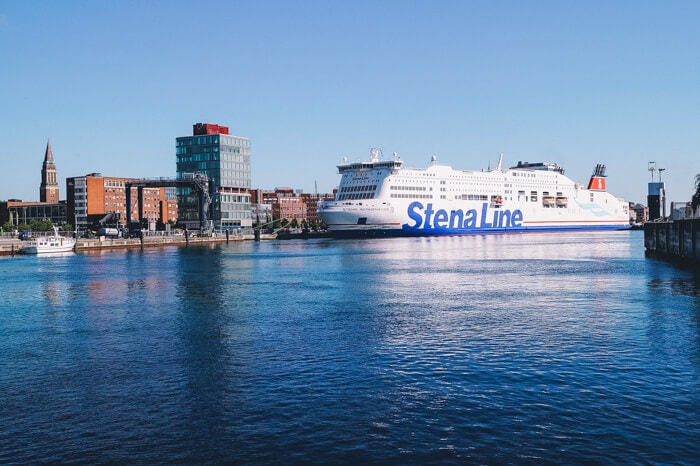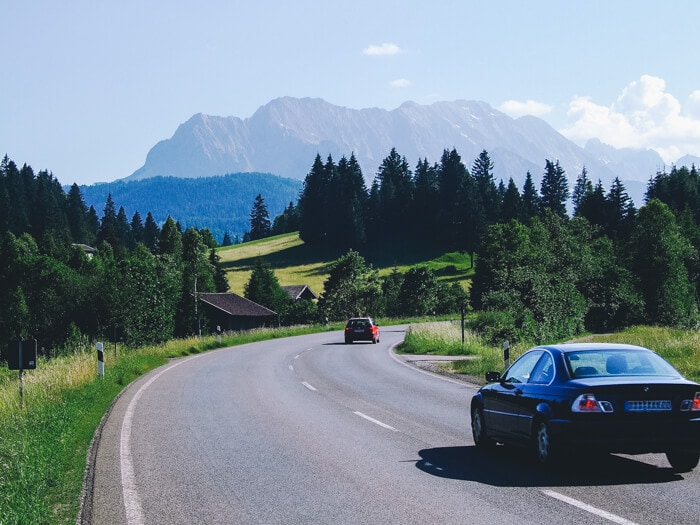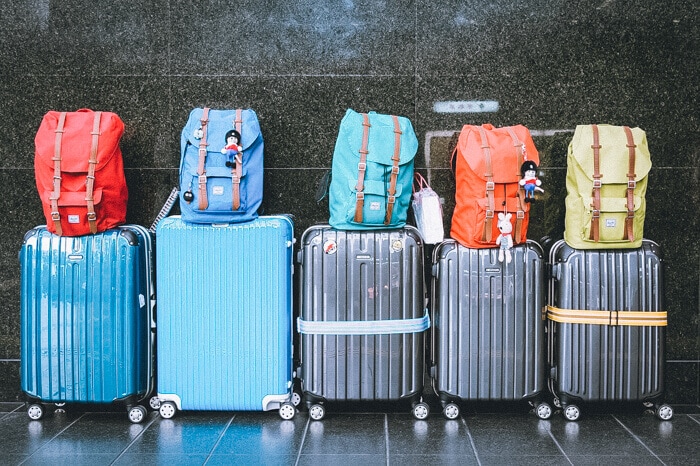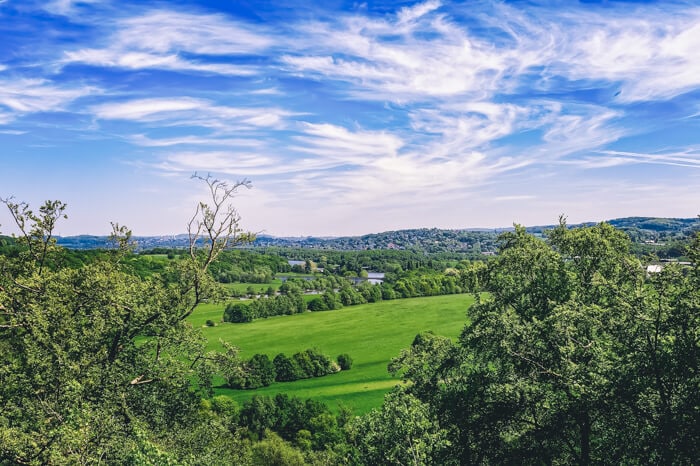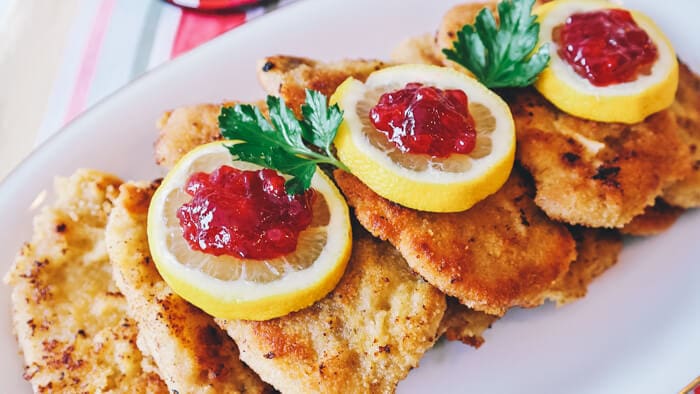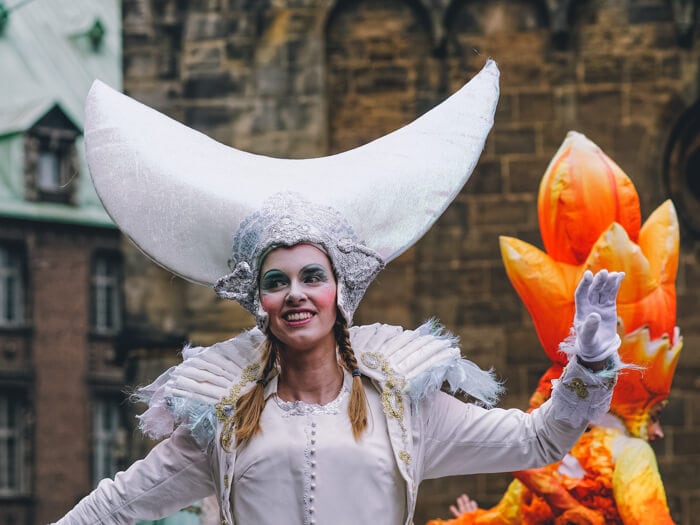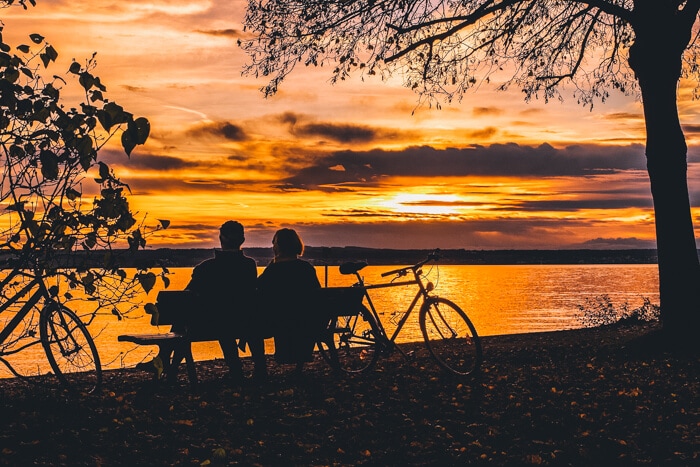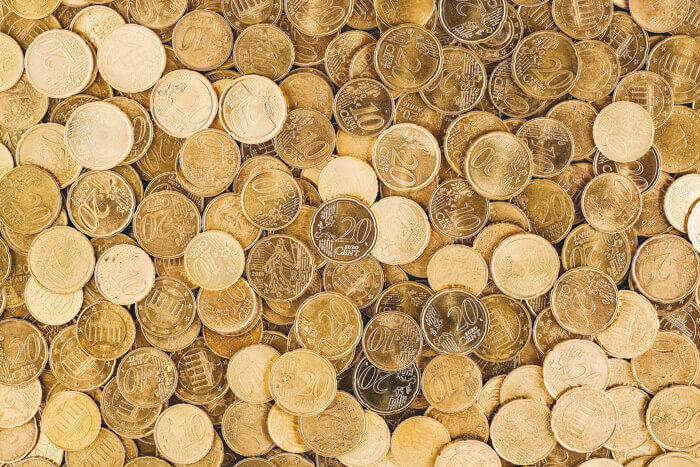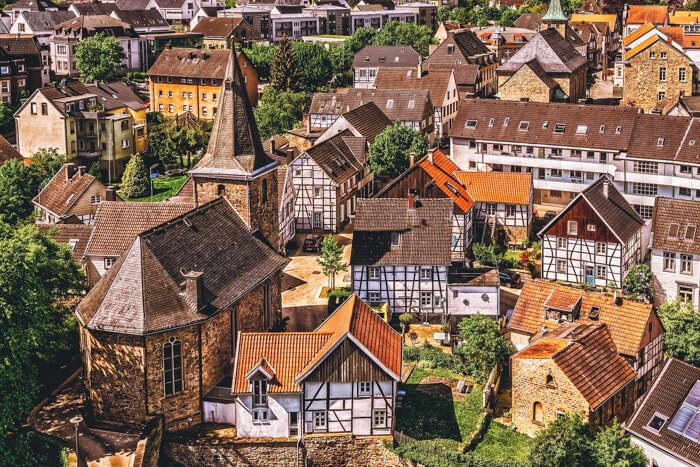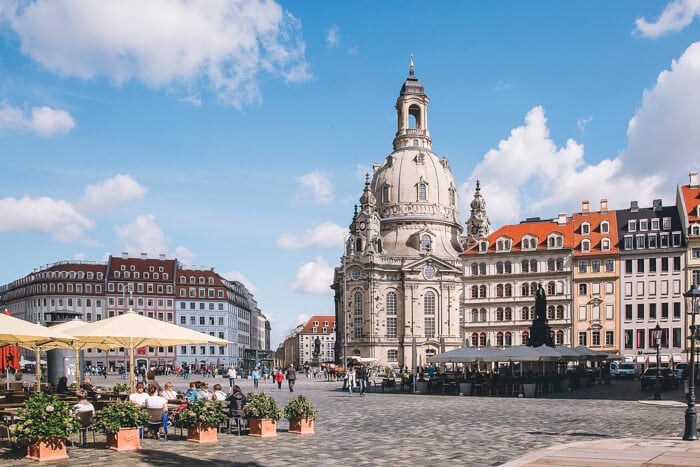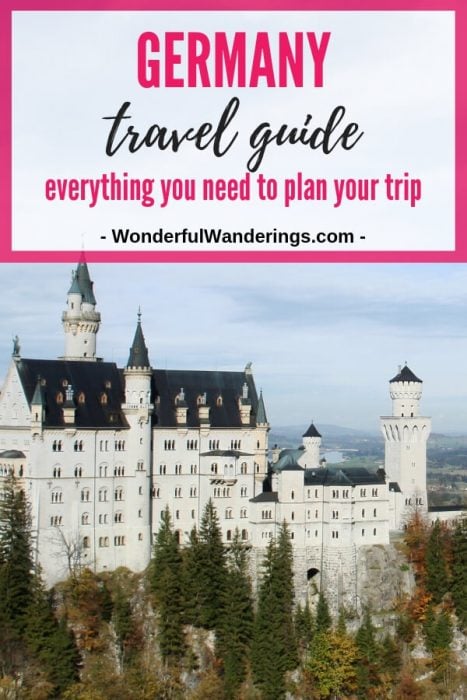Planning a trip to Germany? Great! This Germany Travel Guide will help you with just that.
Germany is situated in Central Europe, is the 7th largest country on the continent and is a member state of the EU and NATO. It’s the most populous nation wholly in mainland Europe, with a population of over 80 million people.
It attracts a similar number of tourists annually, making it one of the most popular destinations in the world. It shares borders with Denmark, Poland, Czech Republic, Switzerland, Austria, France, Belgium, The Netherlands, and Luxembourg. Russia is the only country in Europe that shares borders with more countries.
Why visit Germany? The country is especially known for its world-class museums, fairytale castles, forests and festivals, which include Christmas markets and beer festivals just to name a few. The capital city Berlin attracts thousands of tourists year-round, while Neuschwanstein Castle was the inspiration for the famous Disneyland Castle.
I found you on Pinterest when I decided to travel outside of the United States for the first time (I’m 54). My husband and I decided to go to Germany, so I read pretty much everything you wrote on that as well as what to pack and how to make it on the long plane ride. I’m still reading your posts and planning on another trip. Thank you for all the good advice!” – Reader Colleen.
Contents
- Germany travel guide: Quick facts
- States of Germany
- 1. Berlin
- 2. Bayern (Bavaria)
- 3. Niedersachsen (Lower Saxony)
- 4. Baden – Württemberg
- 5. Rheinland – Pfalz (Rhineland – Palatinate)
- 6. Sachsen (Saxony)
- 7. Thüringen (Thuringia)
- 8. Hessen
- 9. Nordrhein-Westfalen (North Rhine – Westphalia)
- 10. Sachsen – Anhalt (Saxony – Anhalt)
- 11. Brandenburg
- 12. Mecklenburg – Vorpommern
- 13. Hamburg
- 14. Schleswig – Holstein
- 15. Saarland
- 16. Bremen
- How to travel to Germany
- How to travel around Germany
- What to pack for Germany
- The best time to visit Germany
- What to eat in Germany
- Famous events in Germany
- Public holidays in Germany
- Things to know when traveling to Germany
- Where to stay in Germany
- Don’t forget travel insurance
- Basic phrases and their pronunciation
- Is Germany safe?
- The use of cash and cards in Germany
- Calling abroad, WiFi and data use in Germany
- Tipping in Germany
- A brief history of Germany
- More travel tips for Germany Germany
Germany travel guide: Quick facts
Size: 357,168 km² or 137,847 sq mi
People living there: more than 80,716,000
Capital: Berlin
Governmental structure: Democratic, federal parliamentary republic.
National day: October 3
Time zone: Central European Time (CET) / UTC+1 / GMT+1
Currency: euro (EUR)
Power voltage and socket type(s): 230V, plug types F and C. If these plug types don’t match your devices, make sure to pack a universal adapter.
Official religion(s)/Freedom of religion: Freedom of religion. 60% of the population is Christian with the two largest denominations being Roman Catholic and Protestant Evangelical Luthern, followed by non-religious citizens, Muslims, Buddhists, and Hindus.
Official language(s) and general knowledge of English: German is the official language. English is semi-widely spoken.
Drives on this side: right
International driver’s licence accepted? yes
Phone code: +49
Vaccinations needed? None mandatory.
Can you drink the tap water? yes.
More interested in quirky and fun facts? Check out this post with interesting facts about Germany.
States of Germany
Germany is a huge country to explore with different sites and places of interest across the country. Here’s a breakdown of the main places to consider when planning your German vacation.
1. Berlin
Berlin is one of three federal states that are also cities, and it’s the capital of Germany. The city is well known to be one of the fun places to go in Germany, with a reputation for its tolerant and liberal attitude, its historic sights and lively nightlife. Although it’s a vibrant and exciting city, it’s also a great place to relax. It’s a great year-round destination, but Christmas is especially magical, as the city boasts over 50 traditional German markets.
There is a plethora of exciting things to see in Berlin, including the Brandenburg Gate, the East Side Gallery, and the Reichstag building. On top of that, there are fantastic museums, restaurants, and parks meaning that the city offers something for everyone.
2. Bayern (Bavaria)
Bavaria is in the southeast of Germany and is the largest federal state in the country. It arguably has more in common with neighboring countries Austria and Switzerland than the rest of Germany.
It’s known for lederhosen (leather trousers), sausages, and beer, but there’s a lot more to the region than that, with beautiful old towns, a stunning countryside, and the Berchtesgaden National Park. Neuschwanstein Castle, located in the state, is one of Germany’s most magical experiences.
It’s the most popular travel destination in the country, attracting over 8 million tourists every year. The capital of the region is Munich, where the famous Oktoberfest is held and it’s also the home of Germany’s most successful football team, Bayern Munich.
If you’re looking for a lesser-known city, there are plenty of things to do in Nuremberg as well.
3. Niedersachsen (Lower Saxony)
Niedersachsen, or Lower Saxony is in the northwest and has a coastline on the North Sea. The second largest German federal state has a wide range of different landscapes, from the mudflats on the coast of the North Sea to the Weser Uplands.
The state capital, Hanover, is where you’ll find the Herrenhausen Gardens, home to an English landscape garden and the Baroque Great Garden. Other important cities are Goslar, home to the Rammelsberg mines, Bremerhaven and its Maritime Museum, and Lüneburg, which boasts the German salt museum. Braunschweig should also be mentioned, due to its huge collection of European art in the Herzog Anton Ulrich Museum.
4. Baden – Württemberg
The mountainous federal state of Baden-Württemberg can be found in the south of Germany, and it shares a border with Bavaria. It’s the 3rd largest region in the country and is best known for being the home of the Black Forest, which is full of greenery year-round and traditional villages. There are a number of regional dialects spoken in the region.
The capital of this state is Stuttgart, home to the headquarters of both Mercedes-Benz and Porsche, two of Germany’s most famous car manufacturers. Travelers in the region should expect to find hilltop castles, diverse scenery, and tasty cuisine. After Stuttgart, Baden-Baden and Heidelberg are two of the most important towns here.
5. Rheinland – Pfalz (Rhineland – Palatinate)
This southwestern state is one of Germany’s largest wine producing regions and a great place to go if you want to sample Riessling, among others. It’s home to the world’s largest wine festival which takes place every September in Bad Dürkheim. Away from wine, it’s a great place for hikers as there a lot of walking trails and woods.
The capital of the state is Mainz, where you’ll find Jewish synagogues and cemeteries, as well as a beautiful Romanesque cathedral. The Moselle Valley is another popular spot for tourists, with its quaint riverside towns of Bernkastel-Kues and Piesport. The Rhine also flows through this state, which borders Belgium, France, and Luxembourg.
6. Sachsen (Saxony)
Saxony is located in eastern Germany and is known for its fairytale castles and palaces, many of which date back to the Middle Ages. The Elbe River flows through the federal state, where you’ll find its capital, Dresden. Although you’ll find beautiful buildings reconstructed after the Second World War bombings, there’s also some stunning natural beauty in and around Dresden.
Away from the capital, there’s Leipzig, home to one of the greatest musical composers, JS Bach. There are tributes to him in the city’s world-famous classical music and fine art museums. There are some smaller historical towns in the state, like Meissen and Görlitz, while the highest fortress in Europe gives spectacular panoramic views across the green countryside.
7. Thüringen (Thuringia)
Thuringia is underrated and often overlooked by tourists, which is a shame. This state right in the center of Germany has a lot to offer in terms of natural landscapes and cultural attractions. The state is known for its huge forests which occasionally give way to mountain peaks, as well as charming medieval villages.
The capital of Thuringia is Erfurt, which escaped any major damage in World War II and is one of the best-preserved medieval cities in the country. Other places worth a visit are Weimar, the home of the writer Goethe, Jena, where you’ll find the world’s oldest planetarium in operation, and the UNESCO listed Canopy Walk in Hainich National Park.
8. Hessen
Hessen is found in central Germany, with a population of over 6 million people. It’s best known for its forests, the Rhine river, and an intriguing mixture of cities. The capital, Wiesbaden is a Roman spa town which is home to 14 hot springs, wellness centers, well-preserved architecture, and parks.
However, the best-known city in Hessen is undoubtedly Frankfurt am Main, which is the country’s financial center and the largest city in the federal state. It’s home to one of the largest airports in Europe, offering intercontinental flights, so it’s a great destination to fly in or out of. There’s some interesting stuff in the city too, such as the Städel Art Museum and Goethe House.
9. Nordrhein-Westfalen (North Rhine – Westphalia)
North Rhine – Westphalia is Germany’s most populous state, with around 18 million inhabitants, many of them living in the huge city of Cologne and the nearby capital of Düsseldorf. It’s in the west of the country, and the river Rhine, the 2nd longest river in Germany after the Danube flows through the state, and there are spectacular views of it from Cologne’s iconic Gothic cathedral.
Outside of the cities, one of the top tourist attractions in the area is the 18th century Schloss Benrath, a palace with a museum and a garden. Other important cities in the state are Germany’s former capital, Bonn, and Aachen.
- Things to do in Münster in 3 days
- Restaurants in Münster that will make you crave more
- Celebrating the Peace of Westphalia in 5 Münster museums
- Having a jolly good time at the Münster Christmas market
- 10 things to do in Osnabrück
- 15 fun and free open places to visit in Cologne
- 16 of the best restaurants in Cologne and other foodie hotspots
- 10 fun things to do in Cologne, Germany
- A walk along the Rhine River in Düsseldorf
- 5 things to do in Düsseldorf when the weather’s terrible
10. Sachsen – Anhalt (Saxony – Anhalt)
Bordering Saxony, this state is in north-central Germany and where you’ll find some of the highest terrain in the whole of Germany, the Harz Mountains. You’ll find fantastic hiking, biking, and outdoor pursuits in the mountains, and cable cars if you’d prefer to ascend in a more peaceful way. In winter, you can even ski here. As well as the castles and wooden houses that dot the mountains, there’s plenty in the cities too.
The capital of the region is Magdeburg, where Otto I, Holy Roman Emperor is buried in the Gothic cathedral. You’ll also find Martin Luther’s home in the town of Wittenburg, the home of the German reformation.
Top things to do in Dresden in 2 days: a Dresden itinerary
11. Brandenburg
Brandenburg shares borders with Mecklenburg – Vorpommern as well as the capital Berlin. It’s a popular place for Berliners to get away as it’s an easy day trip or weekend break from there. It’s home to natural parks, landscaped gardens, and haunting relics left over from the time of the Nazis.
The capital of the state is Potsdam, known for its picturesque Dutch Quarter, a smaller reconstruction of Berlin’s Brandenburg Gate, and the Sanssouci Palace. Away from the urban centers, the Spreewald forest is a romantic getaway opportunity, and the Babelsberg Park offers a slice of England on the Havel River.
12. Mecklenburg – Vorpommern
A state in northern Germany with a coast on the Baltic Sea, Mecklenburg – Vorpommern is one of 5 states that used to belong to East Germany before the fall of the Berlin Wall. It’s one of the most diverse states in the whole country, with over 1,200km of coastline, a three national parks, and a number of cultural attractions if nature isn’t top of your list.
Although not well known outside of the country, Schwerin is one of Germany’s most jaw-dropping cities and is home to a castle perched on its own island in the middle of a lake. Other major cities in the region are the port of Rostock, the medieval spa town of Waren, historic Stralsund, and several ancient towns dotted around the federal state.
13. Hamburg
Hamburg is another of Germany’s city-states and is home to almost 2 million people. It’s one of the biggest port cities in Europe and has been an important historical and cultural hub for centuries.
However, it’s also an exciting tourist destination thanks to colorful markets, boat cruises, and unique museums. Architecture buffs will love it too – there are several converted warehouses here, with Spiecherstadt being a highlight – where warehouses rub shoulders with neogothic buildings. It’s one of 3 UNESCO World Heritage sites in the city.
Many people visit Hamburg for the nightlife – Reeperbahn, located in the St. Pauli district, is one of the city’s two nightlife centers. It’s actually a red-light district, and it also holds one of the world’s largest techno and nightclub festivals.
14. Schleswig – Holstein
One of Germany’s best-kept secrets, the state of Schleswig-Holstein is one of the country’s most important commercial hubs but it’s only a great destination for tourists. It has picturesque landscapes, islands, and quaint little towns. There are also a number of sandy beaches where you can top up your tan or enjoy some of the regions great surfing.
The capital of this region, situated on the north coast, is the port of Kiel, where you can enter or travel onwards to Scandinavia and Lithuania. One of the most popular attractions in the city is the opportunity to dive into a former German submarine. Another city worth visiting is the pretty Lübeck.
15. Saarland
Saarland, located in the south, is the second smallest state in Germany and it shares borders with both France and Luxembourg. The region is known for its vineyards, picturesque valleys, and historic sites which date back to before the time of Jesus! The capital city is Saarbrucken, and over 1 million people live in the state in total.
Some of the region’s must see attractions include the UNESCO World Heritage listed Völklingen Ironworks, especially when lit up with neon lights at night, the treetop walk near Mettlach which gives outstanding views of the Saarschleife, and the red sandstone Schlossberg Caves.
16. Bremen
Bremen is the third of Germany’s city-states, and the small federal state in Germany, being home to just under 700,000 people. In the past, it was a major port in maritime trade, thanks to its position on the Weser river in north-western Germany. Take some time to wander around the Labyrinthine School District or stroll down Böttcherstrasse.
A city steeped in history with a wide variety of architectural styles, Bremen is a beautiful and interesting place to stay. With Hanseatic buildings in the market square, a Gothic town hall with a Renaissance façade, and medieval crypts and twin spires in the city’s cathedral. Bremen is said to have one of the best Christmas Markets in the whole of Germany.
How to travel to Germany
Entry requirements
Germany is in the Schengen Zone and can be entered freely from other countries within this zone. Citizens from EU countries outside of the Schengen Zone can still enter freely but may have to show their passport or ID on arrival.
Travelers from North America and the rest of the world can enter Germany for up to 90 days without a visa. Passports must be valid for at least 6 months after their stay.
How to get to Germany
By bus
Germany is well connected with its neighbors, and there are long distance international services to Amsterdam, Copenhagen, Milan, and Vienna to name a few. Buses are comfortable and often offer free Wi-Fi and snack bars. Some of these long-distance companies are:
- Busabout
- Eurolines
- Flixbus
Travel to Germany by train
There are rail services which link Germany with the majority of countries in Europe. Long-distance trains which travel to and from other European cities are called EuroCity (EC) trains, while national train travel is courtesy of Deutsche Bahn.
Deutsche Bahn and ÖBB (from Austria) also offer a number of overnight trains to major European cities. You can even take the Eurostar between Germany and the UK if you change to a high-speed train in Paris or Brussels.
Look here for train routes and prices from within Europe.
By ferry
Germany only has a coastline in the north, and the main ports are Kiel, Travemünde, Rostock, and Sassnitz. All ports offer services to Scandinavia. Kiel offers services to Klapéida in Lithuania, and you can travel from Travemünde to Liepāja and Ventspils in Latvia.
Return tickets are often cheaper than one way, and it’s a good idea to book well in advance if you’re traveling with your own car.
Check here for ferry routes and prices to Germany.
Fly to Germany
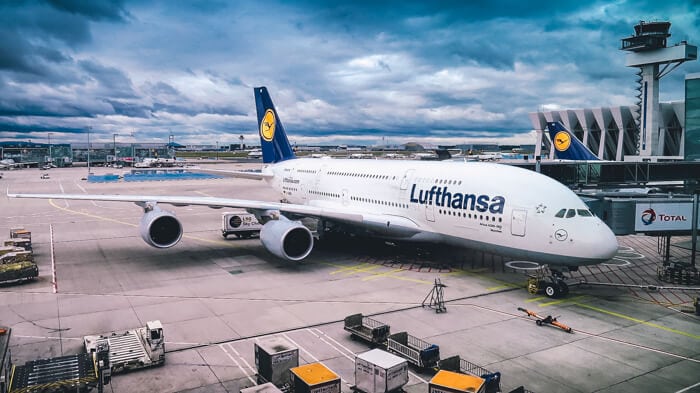
Germany has a number of international airports and its carrier is Lufthansa. It’s a member of the Star Alliance and has one of the world’s best safety records. The majority of national carriers and low-cost airlines offer flights to Germany.
Frankfurt is one of the biggest airports in Europe and offers several transcontinental flights. Munich and Düsseldorf also have large airports. Berlin’s Brandenburg airport is due to open in 2020, but for now, flights to the capital arrive to the smaller airports of Schönefeld and Tegel.
Check here for the best flight options to Germany.
How to travel around Germany
Independent travel around Germany
Germany has an excellent road, rail, and bus system so it’s extremely easy to travel around independently with public transport. Trains are the fastest way to get from city to city if you don’t have your own private transport, but buses are often cheaper. The national rail system is run by Deutsche Bahn – you can buy national and international train tickets via their website.
Germany is also great for those who want to rent a car and explore at their own pace. You’ll just need to carry your driving license and have proof of at least third-party insurance with you.
What to pack for Germany
Germany’s weather can be unpredictable, and it’s a good idea to bring layers, a raincoat, and your swimsuit whichever time of year you’re travelling. The temperate climate differs very little across the country, with warm summers and mild winters. Most of Germany receives the majority of its rainfall during the summer months.
What to pack for Germany in summer
- light hiking trousers
- a reusable water bottle
- good walking sandals
- sneakers
- light clothing
- a rain jacket
- sunglasses
- sunscreen
What to pack for Germany in winter
- a warm wind and waterproof coat
- comfortable and warm shoes
- layers
- a merino woolen baselayer
- merino woolen socks
- a reusable water bottle
- a warm scarf
What to pack for Germany in fall and spring
If you’re going to Germany in fall or spring, it’s mostly important to pack layers. Early fall can still feel like summer while early spring can still be winter cold. You probably won’t need a thick winter coat in these seasons but a warm lightweight jacket is recommended.
The best time to visit Germany
The best time to go to Germany depends completely on what you want from your trip. There’s no bad time to visit, but if you don’t like crowds the best time of year to visit Germany could be the shoulder season – from March to May and October and November.
Summer is a great time to travel Germany, especially if you are outdoorsy, but beware this time of year sees price hikes in accommodation and transport.
Most German towns have magical Christmas markets, and the best time to visit these is in November and December. The famous Oktoberfest is another major tourist draw, so if getting on your lederhösen and enjoying a few steins is your idea of fun, head to Germany in October.
What to eat in Germany
If you truly want to explore Germany, you need to explore its cuisine as well. Get started with the dishes below.
- Bratwurst – A traditional sausage usually served in a bun that you’ll find at every German BBQ.
- Currywurst – Germany’s most loved street food consists of pork sausage, curry powder, and ketchup.
- Spätzle – Handmade noodles that are fried and served with several traditional dishes.
- Sauerkraut – A side dish which consists of fermented sour cabbage. Often served with meat.
- Kartoffelkloesse – Traditional potato dumplings served as a side with meat or as a dish on their own.
- Hasenpfeffer – A rabbit stew braised with onion and wine, with the marinade and sauce thickened with rabbit’s blood.
- Rinderroulade (Beef roll) – Dish from Saxony that consists of beef rolled with onions, pickles, bacon, and mustard before being roasted in red wine.
- Pretzels – A thick, doughy snack often covered in salt or sesame seeds. Eat them on their own or dipped in mustard.
- Lebküchen – Gingerbread cookies sometimes coated in nuts, chocolate, or icing sugar. Popular at Christmas markets.
- Beer – Pilsner, a pale lager is Germany’s most popular beer, but there are many other varieties, including wheat beer and altbier.
Want to know more about German cuisine? Check out this list of German foods.
Famous events in Germany
- Berlin International Film Festival (February) – the 2nd biggest international film festival in the world, after Cannes.
- Leipzig Book Fair (March) – the largest literary festival in Europe where you can meet your favorite authors and learn about all that’s going on in the world of books.
- Karneval (40 days before Easter) – A German take on the famous Venetian celebration. Cologne’s karneval is the best known in Germany.
- Walpurgisnacht (April) – This festival in Heidelberg takes place in one of the only remaining relics of Nazi architecture, a huge amphitheatre. Thousands of torchbearers climb the mountain and pile inside.
- Hafengeburtstag (May) – Over one million people turn up to this festival in Hamburg which celebrates the city’s birthday with boat shows, concerts, fireworks, and an open-air fair.
- Wurstmarkt (September) – In Bad Dürkheim you’ll find the world’s largest wine festival, with over 600,000 people attending every year.
- Unity Day (October) – The largest national holiday which celebrates the fall of the Berlin Wall and the reunification of East and West Germany.
- Oktoberfest (October) – Traditional Bavarian foods, lederhösen, and of course beer at this huge festival held every October in Munich.
- Onionfest (October) – In the market town of Weimar, all things onion are celebrated and “Queen of the Onion” is crowned. Over 300,000 people attend annually.
- Christmas markets/Weihnachtsmarkts (November/December) – Held across Germany, quaint stalls that sell Christmas gifts, food, and gluhwein. The best are in Nuremberg, Cologne, and Hamburg.
- New Year’s Day
- January 6th – Three King’s Day
- March 4th – Fasching
- Good Friday
- Easter Monday
- May 1st – Labour Day
- Ascension Day
- Whit Monday
- June 20th – Corpus Christi Day
- October 3rd – German Unity Day
- October 31st – Day of reformation
- November 1st – All Saints Day
- December 25th – Christmas Day
- December 26th – St Stephen’s Day
Public holidays in Germany
Things to know when traveling to Germany
If you’re traveling to Germany for the first time, it’s good to be aware of a few social customs beforehand.
Use sie (the formal version of you) when speaking to strangers, and only use the informal du and first names if you are invited to do so. The greetings that involve you in the basic phrases section below are all the formal version.
When eating, sat ‘guten appetit’ before starting a meal.
Where to stay in Germany
I always look on Booking.com for hotels and guesthouses. This has a bunch of filtering options so I can easily get a list of only the hotels that meet my criteria. If you’re looking for accommodation in Germany, I highly recommend you check there.
When I want to book an apartment rather than a hotel, I use Airbnb.
Don’t forget travel insurance
No matter how well you plan and research a trip, there are always things that happen beyond your control. Something might get canceled, you can get ill or hurt while traveling or one of your electronics might break or get stolen. When misfortune strikes, travel insurance has got you covered. I’ve had ongoing travel insurance ever since I started traveling to make sure I’m covered for every trip I go on. Don’t have insurance yet? You can get a free quote here:
Basic phrases and their pronunciation
Guten Tag (goot’n tag)
Wie geht es ihnen? (vee gayt es ee-nen)
Mir geht es gut, danke. (Me-er git es gut, dahn-kuh)
Auf wiedersehen (owf vee-dair-zayn)
Bitte (bi-tuh)
Danke (dahn-kuh)
Ja (Yah)
Nein (Nine)
Wie Heißen Sie? (vee hie-ssen zee)
Mein name ist (mine nah-mah is)
Entschuldigen Sie (ehnt-shool-dih-gun zee)
Sorry, aber ich verstehe nicht (sorry ah-about ikh ver-shte-he nikht)
Ich spreche nicht gut Deutsch (ikh spre-kuh nikht goot doytch)
Sprechen sie Englisch? (spre-kehn zee ing-lisch)
Was kostet das? (vas kos-tet das)
Wo ist die toilette? (vo ist dee toi-let-teh)
Konnen Sie mir bitte helfen? (coh-nen zee meer bi-tuh hel-fen)
Hält der zug/bus in …? (haylt der zoog/bus in …)
/
Ein großes bier bitte (eyn grro-ses bee-he bi-tuh)
Good day.
How are you? (formal)
I’m good, thank you.
Goodbye.
Please.
Thank you.
Yes
No
What’s your name? (formal)
My name is…
Excuse me.
I’m sorry, I don’t understand.
I don’t speak German very well.
Do you speak English?
How much is it?
Where is the bathroom?
Can you help me?
Does this train/bus stop in …?
A large beer, please!
Is Germany safe?
Germany has no obvious safety problems and it’s easy to stay safe thanks to its excellent infrastructure and police force. Petty crime is the most common offense and violent crime is rare. In tourist areas, keep an eye on your valuables and don’t give pickpockets any opportunities to take advantage of. Other than that, you shouldn’t worry about travel safety.
If you’re renting or bringing a bike, make sure you have a good, sturdy lock. Bike theft is also a common occurrence in big cities.
The use of cash and cards in Germany
There are over 100,000 ATMs in Germany, and it’s rare that foreign debit and credit cards aren’t accepted, so you shouldn’t have any problems withdrawing cash here. They’re also accepted in most hotels, restaurants, and shops.
You will, however, often need cash at small, independent retailers, cafés, restaurants, and markets.
Calling abroad, WiFi and data use in Germany
Those with a SIM card from an EU country don’t have to pay roaming charges when calling, texting, or using data in Germany. The same goes for some global phone plans.
If you don’t have a EU SIM but still want to have unlimited WiFi, check out Solis Wifi.
Skyroam offers both day passes and monthly subscriptions providing you with 4G throughout your trips. I’ve been using their daily passes not just when I travel outside the EU (no roaming charges for me in the EU) but also as a backup for when I think I’ll go over my phone’s data plan.
Check out Solis Wifi here.
Tipping in Germany
In Germany, service charges are usually included in the bill and tipping is more of a “thank you” gesture than an obligation. Still, people tend to tip waiters in restaurants and especially other tourism-related workers such as taxi drivers and porters. More on who to tip what in Germany here.
A brief history of Germany
The end of the last Ice Age, around 10,000 years ago, is the first time that people settled in Northern Europe. A language similar to Modern German was first spoken around 5,000 years ago, but it was still a long time before German as we know it today was born.
In the 10th century, the German state was known as the Holy Roman Empire. This lasted a long time, and the Catholic and Protestant parts of the empire clashed in the 30 years’ war from 1618 – 48. More than quarter of the population, and half of Germany’s men were killed in this war.
Until 1871, Germany was made up of several small states ruled by Kings and Dukes. A politician called Otto Von Bismarck unified the country using alliances and force.
Germany attempted to compete with other European countries by establishing an empire in Africa and Asia. However, tension from this led to World War 1, at the time the worst war the world had ever seen. The UK, France, and the USA defeated Germany and its allies.
In 1933 Adolf Hitler and the Nazi party came to power. The Nazi party invaded Poland in 1939 leading to World War II. Concentration camps were established across country where many Jews were sent to be murdered. The war ended in 1945, Germany lost, and Hitler committed suicide.
Germany was divided after the 2nd world war into West and East. West and East Germany were an important part of the Cold War and were at the centre of a standoff between the Soviet Union and the West.
Germany opened its borders in 1989 when the Berlin Wall fell.
Nowadays, Germany has one of the most powerful economies in the world and is an important member state of the EU. Angela Merkel is the Chancellor.
And that’s it! I hope this Germany travel guide will help you decide where to go in Germany and plan your own trip there.
Safe travels!
More travel tips for Germany Germany
Planning to travel to Germany? Then check out all my Germany posts
PIN FOR LATER

